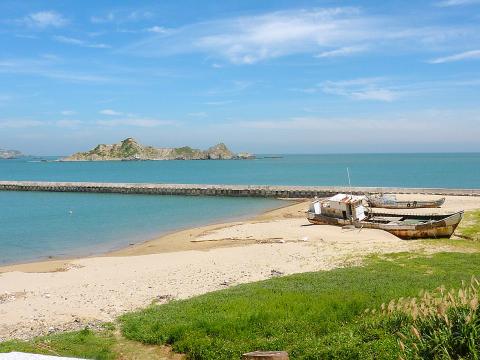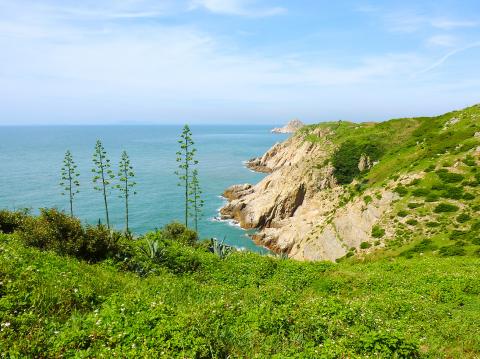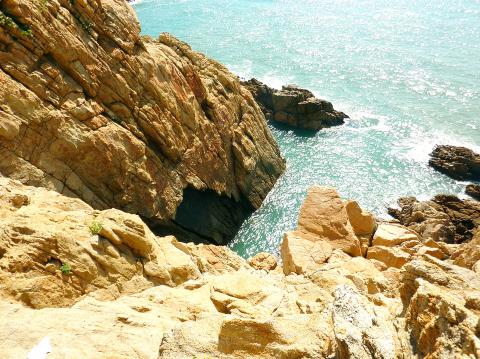The Matsu archipelago, lying just off the coast of China (about 200km northwest of Taipei) remains one of the last frontiers for tourism in Taiwan. Although it briefly rose to prominence in world news during the lead-up to the war, which finally broke out in 1958 between the Republic of China and the Communist People’s Republic of China, Matsu has since sunk back into its former status as a remote, little-visited backwater, about which little is known, even among most Taiwanese.
Civilian visitors were banned from visiting the islands until well into the 1990s, and although curious tourists started trickling in after the islands were declared a National Scenic Area a couple of years after they opened up in 1995, the biggest boost to the islands’ status as a tourism destination came with the promotion, a couple of years ago, of the strange and beautiful natural glowing algae, dubbed “blue tears,” that grows in the sea around several of the islands.
http://192.168.252.104/images/2017/09/08/thumbs/p13-170908-aa4.jpg

Photo: Richard Saunders

Matsu’s famous blue tears (fascinating as they are) are only a seasonal occurrence, and not as clear to the naked eye as those beautiful time-lapse photos that crop up in tourist literature about the islands would have us believe. Happily though, Matsu has vastly more to offer the traveler than glowing algae.
SMALLEST BUT PRETTIEST

Any of the seven accessible islands in the Matsu group — Beigan (北竿), Nangan (南竿), Dongyin (東引), Xiyin (西引), Dongju (東莒), Xiju (西莒) and Daqiu (大坵) — would be a great place for the traveler wanting to get away from the crowds, but if you could pick only one island, I’d suggest spending your time on Dongju. Tiny, exquisite Dongju is one of the smallest of the inhabited islands in the group, just 3.5km long and 1km wide at its widest point, and is not only one of the quietest of the inhabited Matsu islands, but also perhaps the most beautiful.
One of its great attractions is that, unlike the other islands in the group, it’s been largely demilitarized, and it’s possible to explore many of the old military strongholds (although watch your step, and don’t pick anything up) which lie abandoned and open to all, and follow side roads to jaw-dropping views over the island’s magnificent east coast.
You could easily see all the main places on Dongju and follow a few trails in a day visit by boat from the much larger island of Nangan, but I’d strongly recommend staying the night. Dongju is a remarkably friendly and relaxing place, and the pace of life is slow and peaceful; plus a sunset walk along the east coast may well prove to be one of the most magical experiences of a trip to Matsu.Daytrippers and overnighters all arrive at the island’s main harbor, backed by a small settlement of old stone houses, and a pretty crescent of golden sand. The beach is known for Matsu’s second weird, phosphorescent micro-organism, called dinoflagellates, a kind of plankton that washes up on the shore between May and September and glows when trodden on. If staying the night on Dongju, definitely come down here at night to take a look. The island’s main settlement, Daping (大坪), is a pleasant if relatively new small village in the hilly center of the island, less than a kilometer from Mengao Harbor (猛澳港). It’s a 15-minute walk, or a very short hop by scooter, which can be rented at the harbor. Daping is an attractive small place on a hillside, and the main place for both accommodation and food.
BEACH AND LIGHTHOUSE
If time is limited, head north to the little settlement of Fuzheng (福正), which is second to none for sheer charm. Lovely traditional stone houses back the pale golden sands of Fuzheng Beach, which at low tide is one of the largest in all of Matsu, while behind, the rolling hillside of close-cropped grass is capped by the whitewashed Dongju Lighthouse (東莒島燈塔), one of the oldest in Taiwan. Standing at the northern tip of the island, and built to a British design 140 years ago, Dongju Lighthouse is Matsu’s only Grade Two Historic Monument. You can’t go inside, but the view from its base over the sea and surrounding islands is magnificent. Note the long wall accompanying the footpath from the parking area up to the entrance to the lighthouse, which is an original feature designed to shelter visitors from the icy gales that pummel the headland in winter.
The lighthouse stands near the northern extreme of the island’s scenic eastern coastal cliffs, which, for the active visitor, are perhaps the most compelling reason to visit this beautiful island. The entire eastern coast of Dongju, from the lighthouse to the island’s southern tip, is quite magnificent, and its deeply eroded rocky cliffs offer some of the finest coastal scenery in all Taiwan, reminiscent of, say, Cornwall in western England, although on a slightly smaller scale.
Apart from near the lighthouse, there are a couple of main access points to this cliff-path walkers’ and scramblers’ paradise. Follow the main road south from Fuzheng village and then take the second fork on the left, which soon ends at a parking area at the start of a short and easy trail that provides absolutely magnificent views of some of the finest sea cliffs the ROC has to offer. The trail ends at a circular viewing platform overlooking the cliff-bound Mysterious Little Bay (神秘小海灣), which is best seen from another viewing platform on the cliffs beside the coast road a few hundred meters further south.
The main subject of the view from here is the Lu-He Cliff (呂何崖), a pair of rather suggestive rock formations named after Lu Dongbin (呂洞賓) and He Xiangu (何仙姑), two of the Taoist Eight Immortals. Suffice to say Lu was a famously lecherous god, He Xian-gu was a favorite object of his attentions, and these two formations depict the two in an exceedingly compromising position.
Richard Saunders is a classical pianist and writer who has lived in Taiwan since 1993. He’s the founder of a local hiking group, Taipei Hikers, and is the author of six books about Taiwan, including Taiwan 101 and Taipei Escapes. Visit his Web site at www.taiwanoffthebeatentrack.com.

In the March 9 edition of the Taipei Times a piece by Ninon Godefroy ran with the headine “The quiet, gentle rhythm of Taiwan.” It started with the line “Taiwan is a small, humble place. There is no Eiffel Tower, no pyramids — no singular attraction that draws the world’s attention.” I laughed out loud at that. This was out of no disrespect for the author or the piece, which made some interesting analogies and good points about how both Din Tai Fung’s and Taiwan Semiconductor Manufacturing Co’s (TSMC, 台積電) meticulous attention to detail and quality are not quite up to

April 21 to April 27 Hsieh Er’s (謝娥) political fortunes were rising fast after she got out of jail and joined the Chinese Nationalist Party (KMT) in December 1945. Not only did she hold key positions in various committees, she was elected the only woman on the Taipei City Council and headed to Nanjing in 1946 as the sole Taiwanese female representative to the National Constituent Assembly. With the support of first lady Soong May-ling (宋美齡), she started the Taipei Women’s Association and Taiwan Provincial Women’s Association, where she

It is one of the more remarkable facts of Taiwan history that it was never occupied or claimed by any of the numerous kingdoms of southern China — Han or otherwise — that lay just across the water from it. None of their brilliant ministers ever discovered that Taiwan was a “core interest” of the state whose annexation was “inevitable.” As Paul Kua notes in an excellent monograph laying out how the Portuguese gave Taiwan the name “Formosa,” the first Europeans to express an interest in occupying Taiwan were the Spanish. Tonio Andrade in his seminal work, How Taiwan Became Chinese,

Mongolian influencer Anudari Daarya looks effortlessly glamorous and carefree in her social media posts — but the classically trained pianist’s road to acceptance as a transgender artist has been anything but easy. She is one of a growing number of Mongolian LGBTQ youth challenging stereotypes and fighting for acceptance through media representation in the socially conservative country. LGBTQ Mongolians often hide their identities from their employers and colleagues for fear of discrimination, with a survey by the non-profit LGBT Centre Mongolia showing that only 20 percent of people felt comfortable coming out at work. Daarya, 25, said she has faced discrimination since she